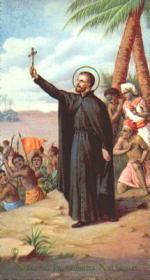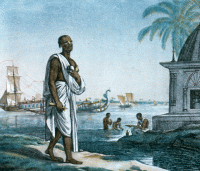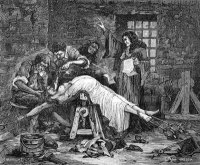 On Dec. 3rd The Asian Age and Deccan Chronicle, India’s widely circulated honorary Catholic newspapers, publishedan article on St. Francis Xavier by Fr.Francis Gonsalves, principal of theVidyajyoti College of Theology, Delhi. Vidyajyoti is a Jesuit theological school and Jesuits as Christian ideologues are known best for their casuistry and sophistry in moral reasoning. Therefore it was not difficult for Fr. Francis to describe Francis Xavier in the article as having “blended a kaleidoscopic collage of virtues: intelligence, faithfulness, perseverance, joy, warmth, devotion, loyalty, courage, generosity, sportsmanship, and an incredible capacity to love and serve.” In fact Xavier was an arch criminal filled with an obsessive hatred of Hindus and their Brahmin priests — Brahmins had defeated him in debate at Thiruchendur and laughed at him when he claimed to be the representative a “One True God”. He introduced forced conversions into India, often targeting children, and was a self-described gleeful breaker of temples and Hindu images. If he was alive and active today, he would be brought before the theInternational Criminal Court in The Hague for crimes against humanity. Yet the
On Dec. 3rd The Asian Age and Deccan Chronicle, India’s widely circulated honorary Catholic newspapers, publishedan article on St. Francis Xavier by Fr.Francis Gonsalves, principal of theVidyajyoti College of Theology, Delhi. Vidyajyoti is a Jesuit theological school and Jesuits as Christian ideologues are known best for their casuistry and sophistry in moral reasoning. Therefore it was not difficult for Fr. Francis to describe Francis Xavier in the article as having “blended a kaleidoscopic collage of virtues: intelligence, faithfulness, perseverance, joy, warmth, devotion, loyalty, courage, generosity, sportsmanship, and an incredible capacity to love and serve.” In fact Xavier was an arch criminal filled with an obsessive hatred of Hindus and their Brahmin priests — Brahmins had defeated him in debate at Thiruchendur and laughed at him when he claimed to be the representative a “One True God”. He introduced forced conversions into India, often targeting children, and was a self-described gleeful breaker of temples and Hindu images. If he was alive and active today, he would be brought before the theInternational Criminal Court in The Hague for crimes against humanity. Yet the Catholic Church and Fr. Francis Gonsalves have the bare-faced audacity to hail this Spanish pirate in public as a saint. This tells us a lot about the values of Christianity and especially Indian Christianity which is known world-wide for its bigotry and religious intolerance. These values are best exemplified by the fact that the rotting corpse of the notorious temple-breaker, known as the Scourge of the Coromandal Coast, is kept in a shrine in the Basilica of Bom Jesus in Old Goa, a church that replaces the Saptakotishwar Shiva Temple of Old Goa destroyed by the Portuguese in the 1590s. Readers are encouraged to go to the links and comments below this article by Sita Ram Goel for more information concerning Francis Xavier and the establishment of the Inquisition in Goa which Xavier demanded that King John III of Portugal send, in a letter dated May 16, 1545. — Editor
Catholic Church and Fr. Francis Gonsalves have the bare-faced audacity to hail this Spanish pirate in public as a saint. This tells us a lot about the values of Christianity and especially Indian Christianity which is known world-wide for its bigotry and religious intolerance. These values are best exemplified by the fact that the rotting corpse of the notorious temple-breaker, known as the Scourge of the Coromandal Coast, is kept in a shrine in the Basilica of Bom Jesus in Old Goa, a church that replaces the Saptakotishwar Shiva Temple of Old Goa destroyed by the Portuguese in the 1590s. Readers are encouraged to go to the links and comments below this article by Sita Ram Goel for more information concerning Francis Xavier and the establishment of the Inquisition in Goa which Xavier demanded that King John III of Portugal send, in a letter dated May 16, 1545. — Editor- Saint Xavier’s Exposition: Why it must stop – Sankrant Sanu
- Mangalore Christian group objects to the exposition of St Francis Xavier’s remains in Goa – India Facts
 St. Francis Xavier: A pirate in priest’s clothing
St. Francis Xavier: A pirate in priest’s clothing
“Goa is sadly famous for its Inquisition, equally contrary to humanity and commerce. The Portuguese monks made us believe that the people worshipped the devil, and it is they who have served him.” – Voltaire
The European encounter between Hinduism and Christianity commenced with the coming of Christian missionaries to Malabar after Vasco da Gama found his way to Calicut in AD 1498. It took a serious turn in AD 1542 when Francis Xavier, a rapacious pirate dressed up as a priest, arrived on the scene. The proceedings have been preserved by the Christian participants. They make the most painful reading in the history of Christianity in India. Francis Xavier had come with the firm resolve of “uprooting paganism” from the soil of India and planting Christianity in its place. His sayings and doings have been documented in his numerous biographies and cited by every historian of the Portuguese episode in the history of India.
Francis Xavier was convinced that Hindus could not be credited with the intelligence to know what was good for them. They were completely under the spell of the Brahmanas who, in turn, were in league with evil spirits. The first priority in India, therefore, was to free the poor Hindus from the stranglehold of the Brahmanas and destroy the places where evil spirits were worshipped. A bounty for the Church was bound to follow in the form of mass conversions.[1]
 We shall let a Christian historian speak about what the Portuguese did in their Indian domain. “At least from 1540 onwards,” writes Dr. Teotonio R. de Souzaof the Dept. of History, Universidade Lusofona, Lisbon, “and in the island of Goa before that year, all the Hindu idols had been annihilated or had disappeared, all the temples had been destroyed and their sites and building materials were in most cases utilised to erect new Christian churches and chapels. Various viceregal and Church council decrees banished the Hindu priests from the Portuguese territories; the public practice of Hindu rites including marriage rites, was banned; the state took upon itself the task of bringing up the Hindu orphan children; the Hindus were denied certain employments, while the Christians were preferred; it was ensured that the Hindus would not harass those who became Christians, and on the contrary, the Hindus were obliged to assemble periodically in churches to listen to preaching or to the refutation of their religion.”[2]
We shall let a Christian historian speak about what the Portuguese did in their Indian domain. “At least from 1540 onwards,” writes Dr. Teotonio R. de Souzaof the Dept. of History, Universidade Lusofona, Lisbon, “and in the island of Goa before that year, all the Hindu idols had been annihilated or had disappeared, all the temples had been destroyed and their sites and building materials were in most cases utilised to erect new Christian churches and chapels. Various viceregal and Church council decrees banished the Hindu priests from the Portuguese territories; the public practice of Hindu rites including marriage rites, was banned; the state took upon itself the task of bringing up the Hindu orphan children; the Hindus were denied certain employments, while the Christians were preferred; it was ensured that the Hindus would not harass those who became Christians, and on the contrary, the Hindus were obliged to assemble periodically in churches to listen to preaching or to the refutation of their religion.”[2]
Coming to the performance of the missionaries, he continues: “A particularly grave abuse was practised in Goa in the form of ‘mass baptism’ and what went before it. The practice was begun by the Jesuits and was later initiated by theFranciscans also. The Jesuits staged an annual mass baptism on the Feast of the Conversion of St. Paul (25 January), and in order to secure as many neophytes as possible, a few days before the ceremony the Jesuits would go through the streets of the Hindu quarters in pairs, accompanied by their Negro slaves, whom they would urge to seize the Hindus. When the blacks caught up a fugitive, they would smear his lips with a piece of beef, making him an ‘untouchable’ among his people. Conversion to Christianity was then his only option.”[3]
 Finally, he comes to “Financing Church Growth” and concludes: “…the government transferred to the Church and religious orders the properties and other sources of revenue that had belonged to the Hindu temples that had been demolished or to the temple servants who had been converted or banished. Entire villages were taken over at times for being considered rebellious and handed over with all their revenues to the Jesuits. In the villages that had submitted themselves, at times en masse, to being converted, the religious orders promoted competition to build bigger and bigger churches and more chapels than their neighbouring villages. Such a competition, drawing funds and diverting labour, from other important welfare works of the village, was decisively bringing the village economy in Goa into bankruptcy.”[4]
Finally, he comes to “Financing Church Growth” and concludes: “…the government transferred to the Church and religious orders the properties and other sources of revenue that had belonged to the Hindu temples that had been demolished or to the temple servants who had been converted or banished. Entire villages were taken over at times for being considered rebellious and handed over with all their revenues to the Jesuits. In the villages that had submitted themselves, at times en masse, to being converted, the religious orders promoted competition to build bigger and bigger churches and more chapels than their neighbouring villages. Such a competition, drawing funds and diverting labour, from other important welfare works of the village, was decisively bringing the village economy in Goa into bankruptcy.”[4]
During the same period, Christianity was spreading its tentacles to Bengal. Its patrons were the same as in Goa; so also its means and methods. “The conversion of the Bengalis into Christianity,” writes Dr. Sisir Kumar Das, “not only coincided with the activities of the Portuguese pirates in Bengal but the pirates took an active interest in it.”[5] The Augustinians and Jesuits manned the mission with bases at Chittagong in East Bengal and Bandel and Hooghly in West Bengal. Mission stations were established at many places in the interior. “It was the boast of the Hooghly Portuguese,” records Dr. P. Thomas, “that they made more Christians in a year by forcible conversions, of course, than all the missionaries in the East in ten.”[6]
 The Portuguese captured the young prince of Bhushna, an estate in Dhaka District. He was converted by an Augustinian friar, Father D’Rozario and named Dom Antonio de Rozario. The prince, in turn, converted 20,000 Hindus in and around his estate. “The Jesuits came forward,” continues Dr. Das, “to help the neophytes to minister to the needs of the converts and this created bitterness between Augustinians and Jesuits…. In 1677, the Provincial at Goa deputed Father Anthony Magalheans, the Rector of the College at Agra, to visit and report on this problem. According to his report nearly 25,000, if not more, converts were there but they had hardly any knowledge of Christianity…. He also observed that many of them became Christians to get money. The Marsden Manuscripts now preserved in the British Museum containing letters of Jesuit Fathers, give evidence that Portuguese missionaries gave money to perspective converts to allure them.”[7]
The Portuguese captured the young prince of Bhushna, an estate in Dhaka District. He was converted by an Augustinian friar, Father D’Rozario and named Dom Antonio de Rozario. The prince, in turn, converted 20,000 Hindus in and around his estate. “The Jesuits came forward,” continues Dr. Das, “to help the neophytes to minister to the needs of the converts and this created bitterness between Augustinians and Jesuits…. In 1677, the Provincial at Goa deputed Father Anthony Magalheans, the Rector of the College at Agra, to visit and report on this problem. According to his report nearly 25,000, if not more, converts were there but they had hardly any knowledge of Christianity…. He also observed that many of them became Christians to get money. The Marsden Manuscripts now preserved in the British Museum containing letters of Jesuit Fathers, give evidence that Portuguese missionaries gave money to perspective converts to allure them.”[7] The quality of the converts, though bewailed frequently by the missionaries, did not really perturb them. Frey Duarte Nunes, the prelate of Goa, had foreseen the situation as early as 1522. According to him, “even if the first generation of converts was attracted by rice or by any other way and could hardly be expected to become good Christians, yet their children would become so with intensive indoctrination, and each successive generation would be more firmly rooted.”[8]
The quality of the converts, though bewailed frequently by the missionaries, did not really perturb them. Frey Duarte Nunes, the prelate of Goa, had foreseen the situation as early as 1522. According to him, “even if the first generation of converts was attracted by rice or by any other way and could hardly be expected to become good Christians, yet their children would become so with intensive indoctrination, and each successive generation would be more firmly rooted.”[8]
It was a very difficult situation for Hinduism. But, by and large, Hindus chose to stay in the faith of their forefathers in spite of all trials and temptations. There was no mass movement towards the Church except the “mass baptisms” staged by the Jesuits. The mission was in a fix. The strategy of forced conversions recommended by Francis Xavier had failed. – History of Hindu-Christian Encounters: AD 304 to 1996, Voice of India, 1996
 Editor’s Addenda
Editor’s Addenda
Sayings of Francis Xavier
In his letters to the Jesuits in Rome, Xavier wrote: “There are in these parts among the pagans a class of men called Brahmins. They are as perverse and wicked a set as can anywhere be found, and to whom applies the Psalm which says: ‘From an unholy race, and wicked and crafty men, deliver me, Lord.’ If it were not for the Brahmins, we should have all the heathens embracing our faith.”
“Following the baptisms, the new Christians return to their homes and come back with their wives and families to be in their turn also prepared for baptism. After all have been baptised, I order that everywhere the temples of the false gods be pulled down and idols broken. I know not how to describe in words the joy I feel before the spectacle of pulling down and destroying the idols by the very people who formerly worshipped them.” Xavier did this after the Hindu raja of Quilon had given him a large grant to build churches!
Xavier’s letter demanding the Inquisition be sent to Goa
Francis Xavier sent this letter to the King John III of Portugal on May 16th, 1545: “The second necessity for the Christians is that your Majesty establish the Holy Inquisition, because there are many who live according to the Jewish law, and according to the Mahomedan sect, without any fear of God or shame of the world. And since there are many spread all over the fortresses, there is the need of the Holy Inquisition and of many preachers. Your Majesty should provide such necessary things for your loyal and faithful subjects in India.” — Joseph Wicki,Documenta Indica, Vol. IV, Rome, 1956.
 The Inquisition in Goa
The Inquisition in Goa
Historian Paul Roberts describes what went on in the Iquisition’s Goa court that had been housed in the Sultan’s old palace and had a huge plaster image of Christ overlooking the scene: “Children were flogged and slowly dismembered in front of their parents, whose eyelids had been sliced off to make sure they missed nothing. Extremities were amputated carefully, so that a person could remain conscious even when all that remained was a torso and head. Male genitals were removed and burned in front of wives, breasts hacked off and vaginas penetrated by swords while husbands were forced to watch…. And it went on for two hundred years.” — Paul Williams Roberts, The Empire of the Soul: Some Journeys in India, New York, 1997.
» Fr. Francis Gonsalves can be contacted at fragons@gmail.com
References
- Francis Xavier was the pioneer of anti-Brahmanism which was adopted in due course as a major plank in the missionary propaganda by all Christian denominations. Lord Minto, Governor General of India from 1807 to 1812, submitted a Note to his superiors in London when the British Parliament was debating whether missionaries should be permitted in East India Company’s domain under the Charter of 1813. He enclosed with his Note some “propaganda material used by the missionaries” and, referring to one missionary tract in particular, wrote: “The remainder of this tract seems to aim principally at a general massacre of the Brahmanas” (M. D. David (ed.), Western Colonialism in Asia and Christianity, Bombay, 1988, p. 85). Anti-Brahmanism has become the dominant theme in the speeches and writings of Indian secularists of all sorts.
- M.D. David (ed.), op.cit., p. 17.
- Ibid., p. 19.
- Ibid., pp. 24-35. For a detailed account of Christian doings in Goa, see A.K. Priolkar, The Goa Inquisition, Bombay, 1961, Voice of India reprint, New Delhi, 1991 and 1996.
- Sisir Kumar Das, The Shadow of the Cross, New Delhi, 1974, p. 4.
- P. Thomas, Christians and Christianity in India and Pakistan, London, 1954, p. 114.
- Sisir Kumar Das, op. cit., p. 5.
- M. D. David (ed.), op. cit., p. 8.
No comments:
Post a Comment